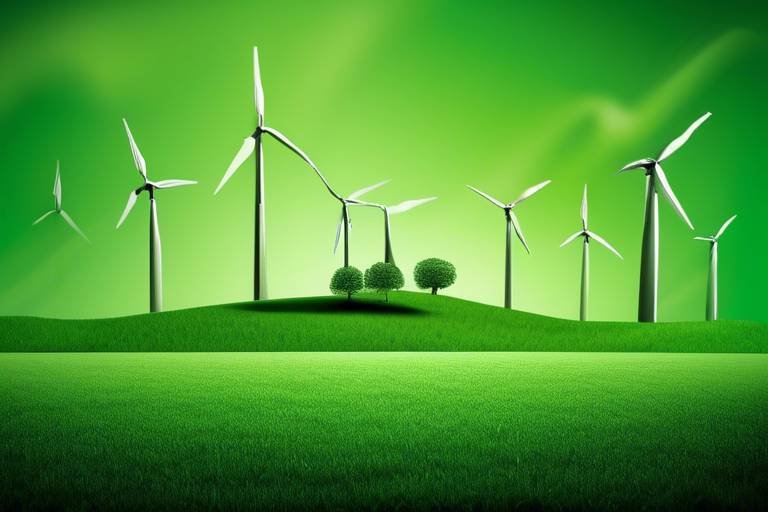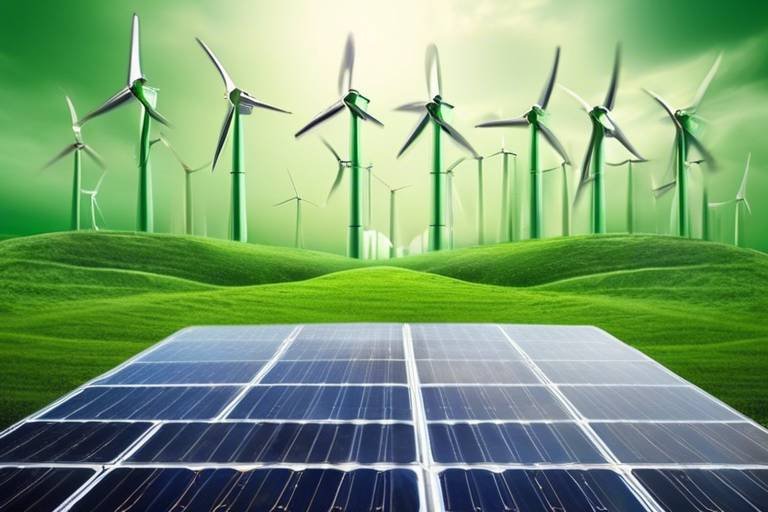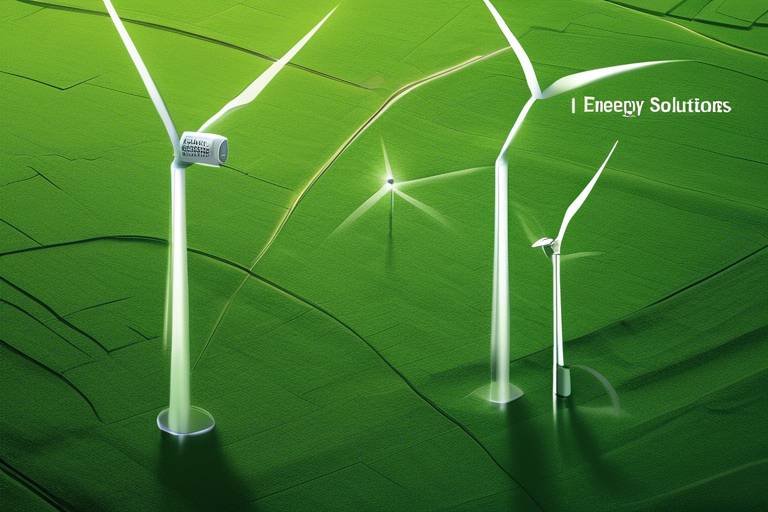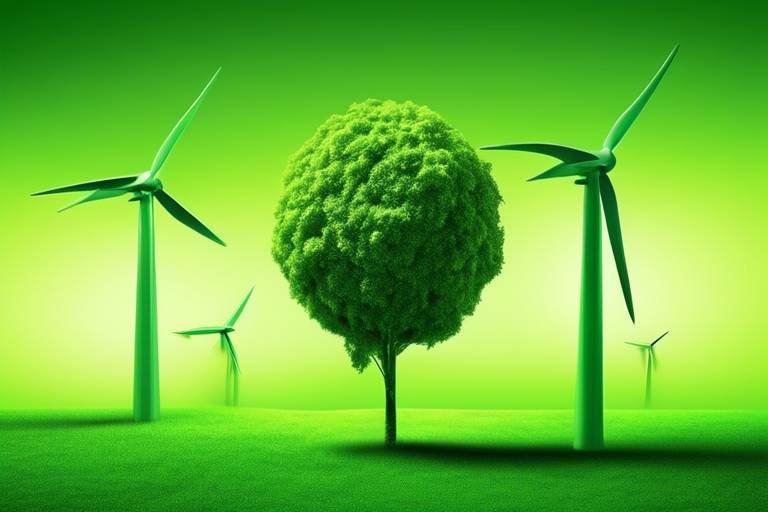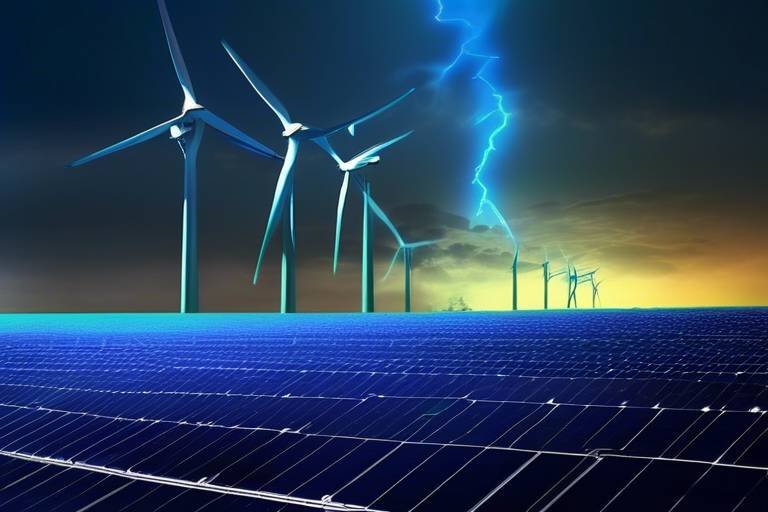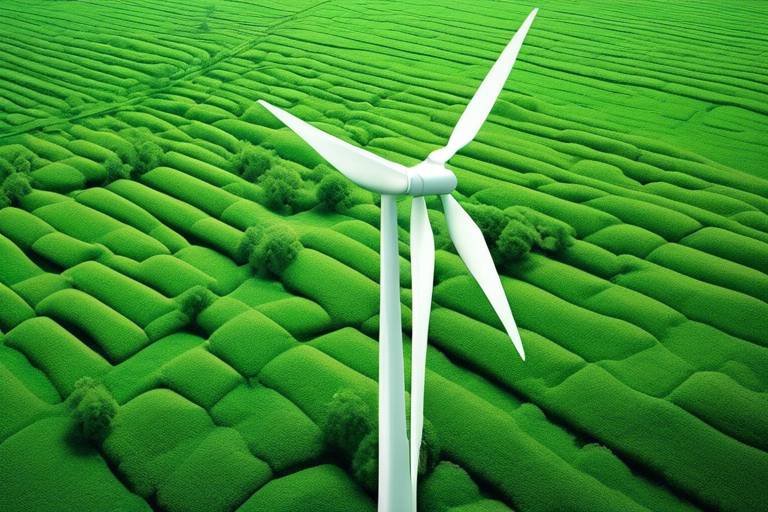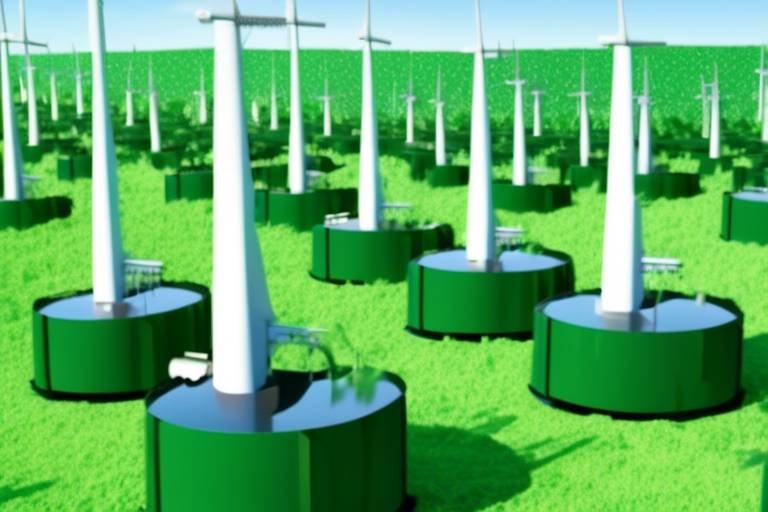Green Energy 101 - Understanding the Basics
Green energy has become a buzzword in recent years, but what does it really mean? At its core, green energy refers to energy derived from renewable sources that have minimal environmental impact. This includes energy produced from sources like the sun, wind, and water. With the world facing the dire consequences of climate change, understanding green energy is more crucial than ever. It represents a shift towards sustainability, aiming to reduce our reliance on fossil fuels and mitigate the harmful effects of greenhouse gas emissions.
The significance of green energy extends beyond just environmental concerns; it plays a vital role in promoting sustainable development and ensuring energy security for future generations. As we delve deeper into the subject, you'll discover how green energy not only helps combat climate change but also fosters economic growth and improves public health. In this article, we will explore various types of green energy, their benefits, challenges, and future trends that are shaping the energy landscape.
So, why should we care about green energy? Imagine a world where our energy needs are met without compromising the health of our planet. Picture cities powered by the sun and wind, where clean air and water are not just a dream but a reality. By embracing green energy, we can turn this vision into a reality, paving the way for a sustainable future. Let’s dive in and explore the fundamental concepts of green energy!
Green energy is not just a trend; it's a necessity. It refers to energy produced from sources that are naturally replenished and have a minimal negative impact on the environment. This includes energy derived from sunlight, wind, rain, tides, waves, and geothermal heat. Each of these sources contributes to a cleaner and more sustainable energy system.
One of the most compelling reasons to transition to green energy is its ability to combat climate change. Traditional energy sources, such as coal and oil, release significant amounts of carbon dioxide and other greenhouse gases into the atmosphere, contributing to global warming. In contrast, green energy sources emit little to no greenhouse gases during operation. By investing in green energy, we can significantly reduce our carbon footprint and help preserve our planet for future generations.
Moreover, green energy promotes sustainability by ensuring that we utilize resources that are abundant and can be replenished. Unlike fossil fuels, which are finite and depleting, renewable resources like sunlight and wind are virtually limitless. This shift not only addresses environmental concerns but also enhances energy security, reducing our dependence on imported fuels and volatile markets.
There are several types of green energy, each with its unique benefits and applications. Understanding these types is essential for recognizing the diverse ways we can harness renewable resources to meet our energy needs. Here’s a brief overview:
- Solar Energy: Harnesses sunlight through photovoltaic cells or solar thermal systems.
- Wind Energy: Generated by converting wind currents into electricity using turbines.
- Hydro Energy: Produced from the flow of water, typically through dams or river currents.
- Geothermal Energy: Utilizes heat from the Earth’s core for heating and electricity generation.
- Biomass Energy: Derived from organic materials like plant and animal waste.
Each of these energy sources plays a critical role in our transition to a more sustainable energy future. As we explore each type in detail, we will uncover not only how they work but also their potential to transform our energy landscape.
The advantages of green energy are manifold and far-reaching. First and foremost, it significantly reduces greenhouse gas emissions, which are the primary drivers of climate change. By utilizing renewable energy sources, we can drastically lower our carbon footprint and contribute to a healthier planet.
In addition to environmental benefits, green energy also promotes public health. Traditional energy production methods often lead to air and water pollution, which can cause serious health issues. By shifting to cleaner energy sources, we can improve air quality and reduce health risks associated with pollution.
From an economic perspective, green energy is a powerhouse for job creation. The renewable energy sector is one of the fastest-growing industries, providing numerous job opportunities in manufacturing, installation, maintenance, and research. This transition not only boosts local economies but also fosters innovation and technological advancements.
- What is the main source of green energy? The primary sources of green energy include solar, wind, hydro, geothermal, and biomass energy.
- Is green energy more expensive than fossil fuels? While initial investments in green energy can be higher, the long-term savings and environmental benefits often outweigh the costs.
- How can individuals contribute to green energy? Individuals can invest in solar panels, support renewable energy policies, and reduce energy consumption in their daily lives.

What is Green Energy?
Green energy refers to energy that is generated from renewable sources which have a minimal impact on the environment. Unlike fossil fuels that release harmful emissions and contribute to climate change, green energy harnesses natural processes to produce power. Think of it as nature's way of providing us with energy without the hefty price tag on our planet's health.
The significance of green energy cannot be overstated. As we face the growing threat of climate change, shifting our focus from traditional energy sources to sustainable alternatives is crucial. By embracing green energy, we are not only reducing our carbon footprints but also promoting sustainability for future generations. Imagine a world where clean air and water are the norm, and natural resources are preserved for our children and grandchildren.
Green energy encompasses a variety of sources, each with its own unique benefits and applications. Some of the most common types include:
- Solar Energy: Harnessing sunlight through solar panels.
- Wind Energy: Utilizing wind turbines to convert wind currents into electricity.
- Hydro Energy: Generating power from flowing water.
- Geothermal Energy: Tapping into the Earth's internal heat.
- Biomass Energy: Using organic materials for fuel.
Each of these sources plays a vital role in our energy landscape, providing alternatives that not only meet our energy needs but also help to mitigate the adverse effects of climate change. As we delve deeper into the world of green energy, it becomes clear that our choices today will shape the future of our planet.
In essence, green energy is not just an option; it's a necessity. By understanding its importance and potential, we can make informed decisions that contribute to a healthier and more sustainable world. So, are you ready to join the green energy revolution?

Types of Green Energy
When we talk about green energy, we're diving into a world filled with innovative solutions that harness the power of nature. This energy is derived from renewable sources, meaning it can be replenished naturally and has minimal impact on our environment. Let's explore the various types of green energy that are making waves in today's energy landscape. Each type has its own unique benefits and applications, contributing to a more sustainable future.
First up is solar energy. This powerhouse of green energy captures sunlight through photovoltaic cells or solar thermal systems. Imagine your roof soaking up the sun's rays and converting them into electricity! Not only does this reduce your carbon footprint, but it also slashes energy costs over time. The beauty of solar energy lies in its accessibility; anyone with a rooftop can tap into this abundant resource.
Next, we have wind energy, which is all about harnessing the natural currents of air. Wind turbines are the iconic structures that convert wind into electricity. Picture vast fields dotted with these towering giants, spinning gracefully in the breeze. Wind energy is rapidly gaining traction as a vital component of the global energy mix, providing a clean and sustainable alternative to fossil fuels.
Then there's hydro energy, generated by the movement of water. Whether it's a large dam or a small river, the flow of water can be transformed into electricity. This type of energy is particularly effective in regions with abundant water resources, making it a reliable source of power. Just think about the potential of rivers and waterfalls—nature's own energy generators!
Geothermal energy taps into the heat stored beneath the Earth's surface. It's like accessing a natural heater that can provide energy for both electricity generation and direct heating. This type of energy is especially prevalent in volcanic regions, where the Earth's heat is more accessible. Imagine using the Earth's own warmth to power your home!
Lastly, we have biomass energy, which involves using organic materials like plant and animal waste to produce energy. This can be in the form of biofuels or biogas, providing a sustainable way to recycle waste into something useful. It's like turning trash into treasure, contributing to a circular economy.
In summary, the types of green energy—solar, wind, hydro, geothermal, and biomass—each offer unique benefits and play a crucial role in reducing our reliance on fossil fuels. By embracing these renewable sources, we can pave the way for a cleaner, more sustainable future. The transition to green energy is not just a trend; it's a necessity for our planet's health and well-being.
| Type of Green Energy | Source | Benefits |
|---|---|---|
| Solar Energy | Sunlight | Reduces electricity bills, low maintenance costs |
| Wind Energy | Wind | Low operational costs, scalable |
| Hydro Energy | Water flow | Reliable and efficient, can provide large amounts of power |
| Geothermal Energy | Earth's heat | Consistent energy source, low emissions |
| Biomass Energy | Organic materials | Reduces waste, versatile energy production |
- What is the main advantage of using green energy? Green energy helps reduce greenhouse gas emissions and combat climate change.
- Can I install solar panels on my home? Yes, if you have a suitable rooftop, solar panels can be installed to harness solar energy.
- Is wind energy reliable? Yes, in areas with consistent wind patterns, wind energy can be a very reliable source of power.
- What is biomass energy? Biomass energy involves using organic materials to produce energy, contributing to waste reduction.

Solar Energy
is one of the most promising forms of renewable energy available today. It harnesses the power of the sun, converting sunlight into electricity through a process that is not only efficient but also environmentally friendly. Imagine the sun as a giant battery in the sky, constantly charging up our planet with energy. This energy can be captured using photovoltaic (PV) cells or through solar thermal systems. But how do these systems actually work? Let's break it down.
Photovoltaic cells are made up of semiconductor materials, usually silicon, that absorb sunlight and release electrons. This movement of electrons generates an electric current, which can be used to power homes, businesses, and even electric vehicles. On the other hand, solar thermal systems use mirrors or lenses to concentrate sunlight, producing heat that can be used to generate electricity or provide hot water. Both methods reduce our reliance on fossil fuels and significantly lower carbon emissions.
One of the most exciting aspects of solar energy is its potential for energy independence. By installing solar panels on rooftops, individuals and communities can generate their own electricity, reducing their dependence on traditional energy sources. This not only lowers energy bills but also provides a sense of empowerment. Moreover, as technology advances, the costs associated with solar energy systems have been steadily decreasing, making them more accessible to the average consumer.
However, it's essential to recognize some challenges that come with solar energy. For instance, the initial investment can be high, which might deter some homeowners from making the switch. Additionally, solar energy production is highly dependent on weather conditions; cloudy days can reduce energy generation significantly. Despite these challenges, ongoing advancements in energy storage solutions, such as batteries, are paving the way for a more reliable solar energy system. These innovations allow excess energy generated during sunny days to be stored and used when the sun isn't shining.
In summary, solar energy is not just a trend; it's a vital part of our transition towards a more sustainable future. With its ability to harness the sun's power, it offers a cleaner, healthier alternative to traditional energy sources. As we continue to innovate and overcome challenges, solar energy could very well become the backbone of our energy systems.
- What are the main benefits of solar energy? Solar energy reduces electricity bills, decreases greenhouse gas emissions, and promotes energy independence.
- How long do solar panels last? Most solar panels come with a warranty of 25 years, but they can last much longer with proper maintenance.
- Can solar energy work in cloudy weather? Yes, solar panels can still generate electricity on cloudy days, although at a reduced capacity.
- What is the average cost of installing solar panels? The cost can vary widely based on location, system size, and installation specifics, but it has been decreasing over the years, making it more affordable.

Benefits of Solar Energy
Solar energy is not just a trend; it's a revolution in how we think about power generation. Imagine waking up every day knowing that the energy powering your home comes from the sun—an abundant and free resource! One of the most significant benefits of solar energy is its low operating costs. Once you've installed solar panels, the cost of harnessing energy drops significantly because sunlight is free. This means that homeowners can enjoy substantial savings on their electricity bills over time, which can add up to thousands of dollars.
Furthermore, solar energy promotes energy independence. In a world where energy prices fluctuate and geopolitical tensions can disrupt supply chains, having your own solar system means you’re less reliant on external sources. You're essentially creating your own little energy oasis, which can be incredibly empowering. This independence is not only beneficial for individuals but also for communities and nations striving for sustainability.
Another remarkable aspect of solar energy is its ability to create jobs in the renewable sector. As the demand for solar installations increases, so does the need for skilled workers in manufacturing, installation, and maintenance. This growing industry contributes to economic development, providing numerous job opportunities that can help revitalize local economies. According to recent statistics, the solar industry has been one of the fastest-growing job sectors, showcasing how green energy can drive economic growth.
Additionally, solar energy has a minimal environmental impact. Unlike fossil fuels, which release harmful emissions and contribute to air pollution, solar energy is clean and sustainable. By choosing solar, you're not just saving money; you're also playing a part in preserving our planet for future generations. The reduction of harmful greenhouse gases is crucial in the fight against climate change, and solar energy is a key player in this battle.
To summarize, the benefits of solar energy are not just confined to financial savings. They extend to energy independence, job creation, and a healthier planet. It's a win-win situation that empowers individuals while contributing to a more sustainable future. So why not consider making the switch? You could be part of a much larger movement toward a greener, cleaner world.
- Is solar energy reliable? Yes, solar energy is reliable, especially with advancements in technology and battery storage systems that allow energy to be stored for use during cloudy days or at night.
- What is the lifespan of solar panels? Most solar panels have a lifespan of about 25 to 30 years, with warranties often covering that duration.
- Can solar energy power my entire home? Absolutely! Depending on the size of your solar system and your energy needs, solar panels can potentially power your entire home.
- Are there incentives for installing solar energy systems? Yes, many governments offer tax credits, rebates, and other incentives to encourage the adoption of solar energy.

Challenges of Solar Energy
While solar energy shines brightly as a sustainable solution, it’s not without its shadows. One of the most significant challenges is the high initial cost of solar panel installation. Many homeowners and businesses hesitate to invest in solar technology due to the upfront expenses, which can be substantial. Although prices have dropped over the years, the initial investment remains a barrier for many. However, various financing options and government incentives can help mitigate these costs, making solar energy more accessible.
Another hurdle is the intermittency of solar energy. Solar panels generate electricity only when the sun is shining, which means that energy production can dip during cloudy days or at nighttime. This variability can lead to challenges in energy supply, especially for those relying solely on solar power. To address this, energy storage solutions, such as batteries, are becoming increasingly important. These systems can store excess energy produced during sunny periods for use when sunlight is scarce, but they also come with their own costs and environmental considerations.
Moreover, the geographical limitations of solar energy can’t be overlooked. Not all locations receive the same amount of sunlight, and areas with less sun exposure may struggle to generate sufficient energy. For instance, regions that are frequently overcast or located far from the equator may not find solar energy as viable. This uneven distribution of solar potential necessitates a diversified energy strategy, incorporating other renewable sources to ensure a reliable energy supply.
Lastly, there’s the issue of land use. Large-scale solar farms require significant land, which can lead to conflicts over land use, especially in densely populated areas or regions with agricultural significance. Balancing the need for renewable energy with the preservation of natural habitats and agricultural land is a complex challenge that requires careful planning and community engagement.
Despite these challenges, the future of solar energy is bright. Continuous advancements in technology and innovative financing solutions are paving the way for broader adoption. As we work through these obstacles, the benefits of solar energy—like reducing carbon footprints and promoting energy independence—are well worth the effort.
- What are the main challenges of solar energy? The main challenges include high initial costs, intermittency, geographical limitations, and land use issues.
- How can the high costs of solar energy be mitigated? Through financing options, government incentives, and technological advancements that lower installation costs.
- What is meant by the intermittency of solar energy? It refers to the fact that solar panels can only generate electricity when there is sunlight available.
- Can solar energy be stored for later use? Yes, energy storage solutions like batteries can store excess solar energy for use during non-sunny periods.
- Are there alternatives to solar energy? Yes, other renewable energy sources include wind, hydro, geothermal, and biomass, which can complement solar energy in a diversified energy strategy.

Wind Energy
Wind energy is one of the most exciting and rapidly growing sectors of renewable energy. It harnesses the natural power of the wind to generate electricity, and it does so in a way that is both efficient and sustainable. But how exactly does this process work? Essentially, wind turbines capture the kinetic energy from wind currents and convert it into mechanical energy, which is then transformed into electricity. This transformation occurs through a series of components, including blades, a rotor, and a generator, all working in harmony to produce clean energy.
Imagine standing on a hilltop, feeling the cool breeze on your face while watching tall turbines gracefully spin against the backdrop of a clear blue sky. It's not just a beautiful sight; it’s a glimpse into the future of energy production. Wind energy is becoming an increasingly significant part of the global energy mix, accounting for a substantial portion of electricity generation in many countries. For instance, in places like Denmark and Germany, wind power contributes to more than 40% of their total electricity needs. This success story showcases the potential of wind energy to transform our energy systems and reduce reliance on fossil fuels.
One of the most appealing aspects of wind energy is its environmental benefits. Unlike traditional fossil fuels, wind power generates electricity without emitting harmful greenhouse gases. This is crucial in the fight against climate change, as reducing carbon emissions is imperative for a sustainable future. Furthermore, wind energy requires significantly less water compared to conventional power plants, making it a great option for regions facing water scarcity.
However, it’s essential to acknowledge that wind energy isn't without its challenges. Some of these include:
- Intermittency: Wind is not always consistent; it can be unpredictable and varies by location and season.
- Initial Costs: The upfront investment for wind farms can be substantial, although operational costs are relatively low.
- Impact on Wildlife: Turbines can pose risks to birds and bats, which raises concerns about their placement.
Despite these challenges, advancements in technology are paving the way for more efficient wind energy solutions. For instance, modern turbines are designed to operate at lower wind speeds and can be installed in various environments, including offshore locations where winds tend to be stronger and more consistent. Innovations in turbine design and energy storage systems are also enhancing the reliability and efficiency of wind energy, making it a more viable option for energy production.
As we look toward the future, the role of wind energy is expected to expand significantly. With countries around the world committing to ambitious renewable energy targets, wind power will likely play a crucial role in achieving these goals. The transition to a greener energy landscape is not just about technology; it's about creating a sustainable and resilient future for generations to come. By investing in wind energy, we are taking a vital step towards reducing our carbon footprint, enhancing energy security, and fostering economic growth through job creation in the renewable sector.
Here are some common questions about wind energy that might help clarify its importance and impact:
- What are the main advantages of wind energy? Wind energy is renewable, reduces greenhouse gas emissions, and has low operational costs.
- How does the efficiency of wind turbines compare to fossil fuels? While individual wind turbines may produce less energy than fossil fuel plants, the cumulative output from multiple turbines can meet significant energy demands sustainably.
- Is wind energy reliable? Wind energy can be intermittent, but advancements in technology and energy storage solutions are improving its reliability.

Benefits of Green Energy
Green energy is not just a buzzword; it's a revolutionary shift in how we think about power and our planet. The are numerous and far-reaching, impacting everything from our health to the economy. By harnessing renewable resources, we can significantly reduce our reliance on fossil fuels and lower greenhouse gas emissions. This transition is crucial in combating climate change, which has become one of the most pressing issues of our time. Imagine a world where clean air is the norm, and energy is abundant and affordable—this is the promise of green energy.
One of the most significant advantages of green energy is its ability to reduce greenhouse gas emissions. Unlike traditional energy sources, such as coal and natural gas, renewable energy sources like wind and solar power generate electricity without emitting harmful pollutants. This reduction in emissions not only helps combat climate change but also leads to improved public health. Cleaner air means fewer respiratory problems and other health issues associated with pollution, ultimately resulting in a healthier population.
Moreover, green energy can drive economic growth in several ways. The renewable energy sector has been a major job creator, offering employment opportunities in manufacturing, installation, and maintenance. For instance, the U.S. solar industry alone employed over 250,000 workers in recent years, and this number continues to grow as more people recognize the importance of sustainable energy. Additionally, as technology advances, the costs associated with renewable energy are decreasing, making it more accessible to individuals and businesses alike.
But the benefits don't stop there. Investing in green energy can also lead to energy independence. By developing local renewable energy sources, countries can reduce their dependence on imported fossil fuels, which often come with fluctuating prices and geopolitical risks. This shift not only bolsters national security but also stabilizes energy prices, making energy more affordable for everyone.
To sum it up, the transition to green energy is not just an environmental necessity; it's a pathway to a sustainable future that offers numerous benefits:
- Reduced greenhouse gas emissions
- Improved public health
- Economic growth and job creation
- Energy independence
As we look forward, the implications of adopting green energy extend beyond just environmental concerns. This transition is a chance to reshape our economy, enhance our quality of life, and secure a healthier planet for future generations. The question now is: are we ready to embrace this change and invest in a brighter, greener future?
Q: What are the main types of green energy?
A: The main types of green energy include solar, wind, hydro, geothermal, and biomass. Each type harnesses natural processes to generate power with minimal environmental impact.
Q: How does green energy benefit the economy?
A: Green energy creates jobs in manufacturing, installation, and maintenance, while also reducing energy costs and promoting energy independence, ultimately contributing to economic growth.
Q: Can green energy completely replace fossil fuels?
A: While green energy has the potential to significantly reduce our dependence on fossil fuels, a complete transition will require ongoing advancements in technology, infrastructure, and policy support.
Q: Is green energy more expensive than traditional energy sources?
A: Initially, green energy sources may have higher upfront costs, but they often lead to lower operating costs and savings over time, making them more economically viable in the long run.

Environmental Impact
The environmental impact of green energy is nothing short of revolutionary. By harnessing energy from renewable sources, we can significantly reduce our carbon footprint and combat the pressing issue of climate change. Imagine a world where the air is cleaner, the oceans are healthier, and wildlife thrives. This is not just a dream; it’s a tangible outcome of adopting green energy solutions.
One of the most striking benefits of green energy is its ability to drastically lower greenhouse gas emissions. Traditional energy sources, such as coal and oil, release a plethora of harmful emissions that contribute to global warming. In contrast, green energy sources like solar, wind, and hydroelectric power produce little to no emissions during operation. This transition is vital for ensuring a sustainable future for our planet.
Moreover, the adoption of green energy can lead to improved public health outcomes. By reducing reliance on fossil fuels, we decrease air pollution, which is linked to respiratory diseases, heart conditions, and even premature deaths. According to various studies, transitioning to renewable energy can save thousands of lives each year by improving air quality and reducing health risks associated with pollution.
Additionally, green energy promotes biodiversity and helps preserve our natural resources. When we rely less on fossil fuels, we minimize the risks of oil spills, habitat destruction, and water contamination. For instance, wind farms and solar installations often occupy less land than traditional power plants, allowing for the coexistence of energy production and wildlife habitats. This balance is crucial for maintaining ecological integrity.
To illustrate the positive environmental impact of green energy, consider the following table that compares the carbon emissions of various energy sources:
| Energy Source | Carbon Emissions (gCO2/kWh) |
|---|---|
| Coal | 900 |
| Natural Gas | 400 |
| Oil | 800 |
| Solar | 50 |
| Wind | 15 |
| Hydro | 30 |
As we can see, the stark difference in carbon emissions between fossil fuels and renewable energy sources underscores the urgent need to shift towards greener alternatives. By embracing renewable energy, we not only protect our planet but also pave the way for a healthier future for generations to come.
In conclusion, the environmental impact of green energy is profound and multifaceted. From reducing greenhouse gas emissions to improving public health and preserving natural ecosystems, the benefits are undeniable. It's a call to action for individuals, communities, and governments to invest in sustainable energy solutions that honor our planet and its resources.
- What is green energy? Green energy refers to energy derived from renewable sources that have minimal environmental impact.
- How does green energy help combat climate change? By reducing greenhouse gas emissions and reliance on fossil fuels, green energy plays a crucial role in mitigating climate change.
- What are some examples of green energy sources? Examples include solar, wind, hydroelectric, geothermal, and biomass energy.
- Can green energy improve public health? Yes, by reducing air pollution from fossil fuels, green energy can lead to better public health outcomes.
- What is the future of green energy? The future of green energy looks promising, with advancements in technology and increasing investments driving its growth.

Economic Advantages
Transitioning to green energy is not just a win for the environment; it also brings a multitude of that can significantly impact our society. By investing in renewable energy sources, countries can stimulate local economies, create jobs, and reduce energy costs. Imagine a world where energy is not only cleaner but also more affordable—this is the future that green energy promises.
One of the most compelling aspects of green energy is its potential to create jobs. According to recent studies, the renewable energy sector has been one of the fastest-growing job markets in the world. From solar panel installation to wind turbine maintenance, the opportunities are vast and varied. In fact, the International Renewable Energy Agency (IRENA) reported that the renewable energy sector employed over 11 million people globally in 2018, and that number is expected to grow. This job creation is crucial, especially in regions that have been economically disadvantaged due to declining industries.
Moreover, green energy can lead to lower energy costs for consumers. As technology advances and the production of renewable energy becomes more efficient, the cost of harnessing these energy sources continues to decline. For example, the cost of solar energy has dropped by more than 80% in the last decade, making it a viable option for households and businesses alike. This reduction in cost means that families can allocate their budgets to other essential needs, such as education and healthcare, rather than high energy bills.
Additionally, investing in green energy reduces dependence on imported fuels, which can be subject to volatile prices. By harnessing local renewable resources, countries can enhance their energy security and stabilize their economies. This shift not only keeps money within the local economy but also fosters energy independence, making nations less vulnerable to geopolitical tensions and market fluctuations.
To illustrate the economic impact of green energy, consider the following table that compares the job creation potential of various energy sectors:
| Energy Sector | Estimated Jobs Created per Megawatt (MW) |
|---|---|
| Solar Energy | 5-7 jobs |
| Wind Energy | 3-4 jobs |
| Biomass | 2-3 jobs |
| Hydropower | 1-2 jobs |
As seen in the table, solar energy leads the way in job creation, showcasing its potential to drive economic growth. It's not just about numbers; it's about the livelihoods of people who depend on these jobs for their families and communities.
In summary, the economic advantages of green energy are profound and multifaceted. From job creation and lower energy costs to enhanced energy independence and security, the shift towards renewable energy sources is not only necessary for a sustainable future but also beneficial for our economy. By embracing green energy, we are investing in a brighter, more prosperous future for everyone.
- What are the main benefits of green energy?
Green energy reduces greenhouse gas emissions, improves public health, and promotes economic growth through job creation and lower energy costs.
- How does green energy contribute to job creation?
The renewable energy sector is rapidly expanding, creating millions of jobs in various fields such as installation, maintenance, and manufacturing.
- Can green energy really lower energy costs?
Yes, advancements in technology and increased efficiency in renewable energy production have led to significant cost reductions, making it more affordable for consumers.
- What role does government policy play in green energy?
Government policies, such as subsidies and tax incentives, can help accelerate the transition to renewable energy by making it more financially viable for both businesses and consumers.
Frequently Asked Questions
- What is green energy?
Green energy is energy that comes from renewable sources, such as sunlight, wind, and water, which have a minimal environmental impact. It's crucial for combating climate change and promoting sustainability in our daily lives.
- What are the main types of green energy?
The primary types of green energy include solar, wind, hydro, geothermal, and biomass. Each type has unique characteristics and applications that contribute to a more sustainable energy landscape.
- How does solar energy work?
Solar energy is harnessed by using photovoltaic cells or solar thermal systems to convert sunlight into electricity or heat. This technology plays a significant role in reducing carbon footprints and lowering energy costs.
- What are the benefits of using solar energy?
Solar energy offers numerous advantages, such as low operating costs, energy independence, and the potential for job creation in the renewable sector, all of which positively impact both the economy and the environment.
- What challenges does solar energy face?
Despite its benefits, solar energy has challenges, including high initial installation costs and reliance on weather conditions. However, ongoing advancements and incentives are paving the way for broader adoption.
- How is wind energy generated?
Wind energy is produced by converting wind currents into electricity using turbines. As technology improves, wind energy is becoming increasingly significant in the global energy mix.
- What are the environmental benefits of green energy?
Green energy significantly reduces greenhouse gas emissions, helping to mitigate climate change and preserve natural resources. By adopting green energy, we can contribute to a healthier planet for future generations.
- How does green energy impact the economy?
Transitioning to green energy contributes to economic growth by creating jobs in the renewable sector and reducing energy costs for consumers and businesses alike, providing a win-win for society.

